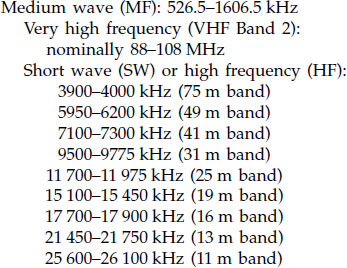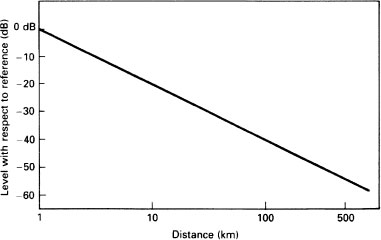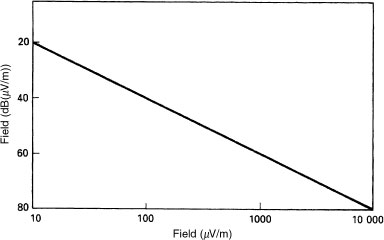The Broadcast Range of Frequencies

Effective Isotropically Radiated Power (EIRP)
This is the product of power fed to the actual antenna multiplied by the antenna gain with respect to an isotropic antenna which radiates uniformly in all directions. Figure 135 shows how the power density varies with distance for an EIRP of 1 kW.

Figure 135 Variation of power density with distance for an EIRP of 1 kW.The reference (0 dB) at 1 km is approximately 7.96 × 10−5 W/m
Reference Field Strength
This is 1 μV/m. Other fields are usually quoted as dB with respect to this reference. Figure 136 shows the relationship between dB μV/m and the field in μV/m.

Figure 136 Relationship between field strength and decibel field
The Ionosphere
This stretches from approximately 50 km above the earth. It results from UV and X-radiation and also high energy charged particles from the sun. For convenience the ionosphere is divided into the D,E and F layers, the last splitting at times into F1 and F2 layers. Figure 137 shows the heights of the layers in a simplified way and also the nature of the variations in height throughout the day.

Figure 137 Ionospheric layer heights with diurnal variations (simplified)
Median field strength for f.m. broadcasting in band-2 VHF
|
Field strength (dB) |
|
Area |
Monophonic |
Stereophonic |
Rural |
48 |
54 |
Urban |
60 |
66 |
Large cities |
70 |
74 |
Critical frequency (Fcrit) is the maximum frequency reflected back to earth at vertical incidence from a given layer.
Typical values are:
FcritE = 4 MHz
FcritF1 = 6 MHz
FcritF2 = 15 MHz
Properties of the Layers
D layer. Approximately 50 to 90 km above the earth. During daytime MF waves are almost completely absorbed by this layer. At sunset absorption decreases rapidly so that skywave reflection from the E layer occurs.
E layer. About 110 km above the earth. MF signals are reflected from it at night time. Lower frequency HF waves can also be reflected in the daytime. Maximum ionization happens in summer at around noon.
Sporadic E (Es) occurs when clouds of intense ionization form. Abnormal propagation over large distances may then take place.
F layer. Upwards of about 150 km. It splits in the daytime into F1 and F2.
F1 is around 200 km above the earth and has greater ionization than the E layer resulting in higher critical frequencies. FcritF1 peaks in summer.
F2 is about 300 km above the earth. Ionization is greater than in any of the other layers. FcritF2 is greater in winter than in summer.
